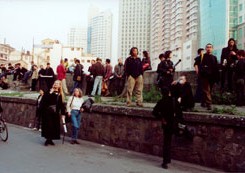I can still more or less recall the evening, at dusk, of November 4, 2000. I came in a taxi to a street along Suzhou Creek in the suburbs of Shanghai—a river dike on one side and old factories and warehouses on the other. Immediately I recognized some arty-looking people strolling and smoking on the side of the road before I had even found the number on the door. I stopped the taxi alongside them and asked where the entrance of Eastlink Gallery was. Inside, at the most prominent position, hung a work by Ai Weiwei, “Gold Distribution”: an enormous black and white photo of a tightly packed group of people in a queue, a reproduction of a famous photo taken by Henri Cartier-Bresson in 1949 (the year the Chinese Communist Party established the People’s Republic of China). I didn’t pay much attention at the time to the name of the exhibition “Fuck Off,” or “Uncooperative Approach” in its Chinese translation. I came mainly because of its reputation as the external exhibition for the Shanghai Biennale. Knowledge of this kind of exhibition seldom depended on formal invitations; rather, the information was passed on by insiders through word of mouth.
In this massive and sturdy former warehouse, the exhibition space on the ground floor was dirty and crude, reeking of filth. Upstairs, on the contrary, was clean, bright and spacious. The upper floor was the gallery space; the bottom floor was rented out for the short term. As is the case for this kind of exhibition, I saw several acquaintances, some eccentrically dressed characters and many foreigners. The artist, Ding Yi, handed me a catalogue, along with an “underground” rumor—many young artists were being presented here, a number of whose works contained literally “raw material”—skin and flesh. Several weeks later I visited Li Liang, the owner of Eastlink Gallery. By then the exhibition was already down; some abstract paintings by Shanghainese painters were leaning against the wall in the empty gallery. In the office, in his usual nonchalant manner, Li Liang mentioned that the Cultural Inspection Bureau had come after the opening. They claimed that some of the works were inappropriate and demanded that the exhibition close. All the remaining catalogs were confiscated as they were being sold without government publication authorization.
There were forty-six artists showing in “Fuck Off,” including the works of Zhang Shengquan who had recently committed suicide. The Cultural Inspection Bureau considered several works to be inappropriate. Photographs by Xu Tan were considered pornography and taken away. Another work of photography, by Yang Fudong, “The First Intellectual,” (2000) also suffered the same fate. In this image, a young man standing in the middle of a road, in a torn suit and loosened tie, his head covered in blood, is holding a brick in his hand as if to make a counter-strike; the background was the new avenues of Pudong District of Shanghai and the newly finished tallest building in Asia, the Jinmao Tower. In this year of 2000, Yang Fudong had not yet become famous. The performance piece “Eating People” by Zhu Yu, often referred to as “Eating Baby,” the most controversial work of the exhibition, was in fact not displayed. On the opening night, a rumor spread that the baby-eating photos were in a black suitcase in the corner of the exhibition space. This artist had in the past used parts of corpses in his artworks. For this exhibition he traveled with the black suitcase from Beijing to Shanghai by train. The curatorial team was worried that its contents were nevertheless still too sensitive, and therefore did not display them. When the Cultural Inspection Bureau came, Zhu Yu had already returned to Beijing with the suitcase. However, the photos and their accompanying texts nonetheless were included in the catalogue. Also in the catalogue were images of the young female artist Peng Yu’s “Oil of Human Being” (2000) which, too, provoked considerable controversy, the title needing no explanation.
